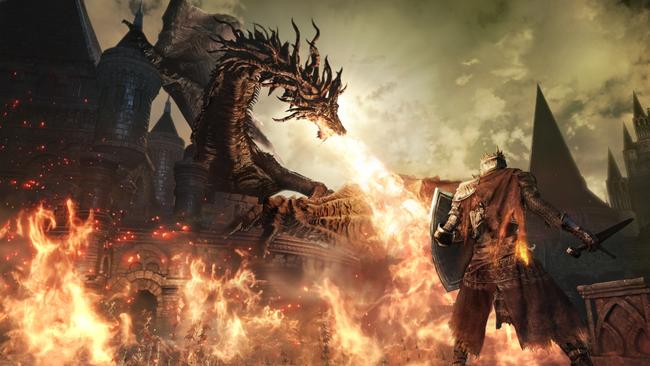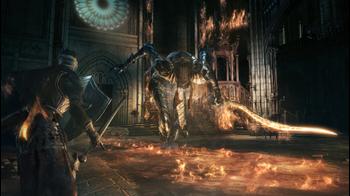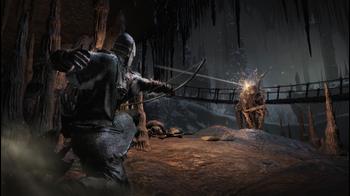
Faster and slicker but no easier: Hands-on with Dark Souls III
If I'm entirely honest with you all, I was sort of dreading my first opportunity to go hands-on with Dark Souls III. For me, the Souls games are something best experienced at home with the curtains drawn and the lights off - mainly to contain any sense of shame at multiple deaths and poor in-game performance to myself. Playing it in a room with other press and the PR chap handling the game present is thus rather daunting - but it's to Dark Souls III's credit that after a few minutes I didn't much care that I was playing in front of others - quickly I was more obsessed with dashing back to where I'd died to take back the souls I'd lost.
While Dark Souls II is pretty damn good in its own right, it still has to be said that many didn't think the game quite stood up to its predecessor's greatest moments. Many chalk that up to series creator Hidetaka Miyazaki stepping away from the director's chair for the second entry; but he's back in that role for the third, and based on our half an hour of hands-on time he appears to be delivering something familiar augmented with small tweaks that have a larger gameplay impact than you'd expect.

It'd be amiss to not mention Bloodborne here, the Souls-alike game Miyazaki developed for Sony while Dark Souls II was in production. The largest thing Bloodborne bought to the table was a stronger sense of freedom of movement, with the player character more focused on deftly dodging than blocking. This concept appears to have transferred at least in part to Dark Souls III - while blocking is still vital, with certain weapons and load-outs dodging and flipping out of harm's way could be equally as viable in some situations.
Before our demo begins, we're given a hands-off presentation from some of the development team from Japan, and they appear keen to point that out. Long and Short bows now function differently, for instance, with shortbows firing weaker shots from a third person locked-on perspective while also allowing the player to quickly roll or dodge if necessary.
The developer leading the demo describes the shortbow's combat style as 'Legolas-like', while using the Longbow remains more rigid - but the trade off is that it's more deadly, doing more damage to enemies for each shot landed.
The new potential for speed as a core strategy is also demonstrated in the form of dual-wielded scimitars, weapons that encourage the player to slash wildly at enemies with speed.
These appeared very effective against smaller, weaker enemies, but far more difficult to use against enemies that are more powerful and less easily knocked into a state of hitstun.
New weapon-exclusive 'Weapon Arts' techniques will also help to further set weapons apart. These attacks essentially resemble 'ultimate' moves somewhat - though being Souls, this isn't going to one-hit-KO enemies, and also seem fairly difficult to land, requiring you to make yourself vulnerable for a moment in switching to a specific stance before using them.
The previously-mentioned scimitars have a great 'whirlwind' spin-attack, for instance, while greatswords have a sweeping upwards swing that can send enemies flying. In my short demo I found these pretty satisfying to use - but they can only be used a limited amount, with your uses restored by resting at bonfires.
This new feature is another great example of small changes that end up having a much larger impact, a theme in Dark Souls III.
The new arts make certain weapons more effective in certain situations; the Longsword has a couple of different arts techniques that serve as great ways to break through an enemy's guard, making it perfect for Knights and the like. Furthermore, with the arts placed on the left trigger the way shields work has now been significantly adjusted too, with different types of shields working in slightly different ways.
The area I got to play around in was The Wall of Lodoleth, a castle that seems like it makes up a pretty typical Souls starting dungeon, complete with the castle's resident dragon. This time the dragon can be coaxed into attacking certain areas and taking out some enemies for you, which ends up being rather useful.
While dodging is now more viable, this still isn't Bloodborne. Quickly I have my wake-up call when ambushed from an enemy hiding behind an archway - keep your guard up, check your corners, and have your shield constantly ready.
This all feels like Souls, alright, but the increased movement speed does a lot to make the game feel more flexible and modern - even if it doesn't make it any easier.
A matter of weeks after E3, it's reassuring to be able to report that the game looked and moved better than it did during that show's hands-off demo of the very same area. There's some lovely lighting at play, and there definitely appears to be a larger scope, though of course for this demo we were limited to a small area.
The boss of the area, a gigantic sword-wielding terror with a stooped back and distinctly feminine movement, was a design highlight, and I rather enjoyed looking at it the three times I reached it before it swiftly killed me.
Between weapon arts and the slicker movement, Dark Souls III appears to be more of the same but with subtle tweaks that add up to be more than the sum of their parts - something I strongly suspect is precisely what most fans of the series want - and it proves that despite briefly stepping away from the series, Miyazaki's vision for Souls remains relatively and perhaps reassuringly static. I just can't wait to play it in a setting where I'm not embarrassing myself so much.

